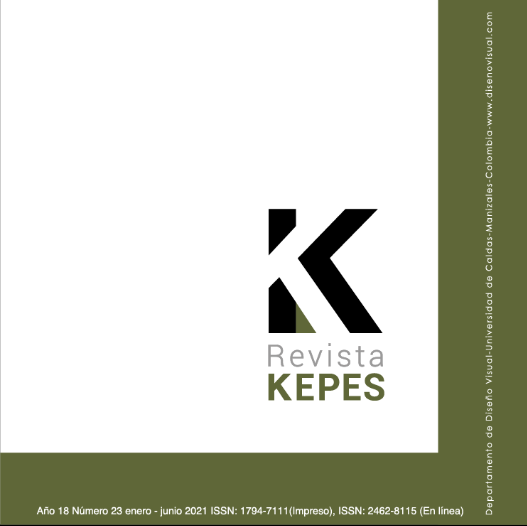Authors
Abstract
Global and local population aging is a reality that challenges all disciplines including design. The Valparaiso Region has the highest proportion of people ≥ 60 years of age or Older Adults (OA) in the country. Among the problem-situations faced by this population group, especially those who are in a social environment with multiple deficiencies and vulnerabilities, is malnutrition. Chile has a complementary feeding program oriented to the OA. However, it has not yielded the expected results. This article describes and analyzes a design experience carried out in Valparaiso in the context of a social project that seeks to improve the effectiveness of the public feeding program. Methodologically, the experience consisted of the participatory design of a system
of healthy food preparations for self-sufficient older adults, considering, on the one hand, the socio-demographic, health, habits and food preferences characterization of a group of selfsufficient older adults and, on the other hand, the development of participatory design workshops to collaboratively build the communication system of the project: brand and food label. In addition, food preparations were delivered to be tasted and valued by the OAs for three months. Participation was voluntary with the signing of an informed consent form. Results: the positive attributes of the brand and labels most highlighted by the OAs are the following: the novel design, the name, the drawings, the eye-catching colors; in addition, the aspects that should be adjusted, from the perspective of the OAs, are: larger and clearer letters. From the analysis of the experience, three critical factors for this level of social design are identified: 1) The role of the designer in a "social model" of professional intervention; 2) the role of the user-participant in the co-design process; and 3) the role of design in the social context.
References
Atalah, E. y Masi, C. (2008). Análisis de la aceptabilidad, consumo y aporte nutricional del programa alimentario del adulto mayor. Revista Médica de Chile, 136(4), 415-422. https://www.researchgate.net/publication/41145700_Analisis_de_la_aceptabilidad_consumo_y_aporte_nutricional_del_programa_alimentario_del_adulto_mayor
Baca, N. y Herrera, F. (2016). Proyectos sociales. Notas sobre su diseño y gestión en territorios rurales. Convergencia, 72, 69-87. http://www.scielo.org.mx/scielo.php?script=sci_arttext&pid=S1405-14352016000300069
Banco Mundial. (2020). El comercio al servicio del desarrollo. En la era de las cadenas de valor mundiales. Panorama general. https://openknowledge.worldbank.org/bitstream/handle/10986/32437/211457ovSP.pdf
Bonsiepe, G. (2012). Diseño y Crisis. Valencia: Campgràfic Editors.
CEPAL. (2017). Panorama Social de América Latina, 2016. https://www.cepal.org/es/publicaciones/41598-panorama-social-america-latina-2016
CEPAL. (2020). América Latina y el Caribe ante la pandemia del COVID-19. Efectos económicos y sociales. https://www.cepal.org/es/publicaciones/45337-
america-latina-caribe-la-pandemia-covid-19-efectos-economicos-sociales
EUROSTAT y OCDE. (2006). Manual de Oslo (3ª Ed.). http://www.itq.edu.mx/convocatorias/manualdeoslo.pdf
Hussain, S., Sanders, E. B-N. y Steinert, M. (2012). Participatory Design with Marginalized People in Developing Countries: Challenges and Opportunities Experienced in a Field Study in Cambodia. International Journal of Design, 6(2), 91-109. https://www.researchgate.net/profile/Martin-Steinert/publication/263162024_Participatory_Design_with_Marginalized_People_in_Developing_Countries_Challenges_
and_Opportunities_Experienced_in_a_Field_Study_in_Cambodia/links/544159480cf2a6a049a57676/Participatory-Design-withMarginalized-People-in-Developing-Countries-Challenges-andOpportunities-Experienced-in-a-Field-Study-in-Cambodia.pdf
Instituto Nacional de Estadística. (2015). Encuesta nacional del uso del tiempo 2015. Síntesis de resultados. https://www.ine.cl/docs/default-source/usodel-tiempo-tiempo-libre/publicaciones-y-anuarios/publicaciones/sintesisresultados-actividades-personales-enut.pdf?sfvrsn=fd9a7cea_6
Instituto Nacional de Estadística (2018). Memoria del Censo 2017. Santiago de Chile. https://www.censo2017.cl/memoria/descargas/memoria/libro_memoria_censal_2017_final.pdf
Jagtap, S. y Larsson, T. (mayo, 2018). Design and frugal innovations: Three roles of resource-poor people (Proceedings of the International Design Conference). The Design Society Croacia, 2657-2668. https://www.designsociety.org/multimedia/publication/308e56d0ab2aec1a7879093cc446bd960b1a00cb0b3b2e0215a920f2f1be97e212919bab1525938610.pdf
Ministerio de Salud de Chile. (2014). Programa Nacional de Salud de las personas Adulto Mayor, MINSAL 2014.
https://www.minsal.cl/sites/default/files/files/Borrador%20documento%20Programa%20Nacional%20de%20Personas%20Adultas%20Mayores-%2004-03_14.pdf
Ministerio de Salud de Chile. (2016). Norma Técnica de los Programas Alimentarios (PACAM).
https://www.minsal.cl/wp-content/uploads/2015/09/2016.04.20-Norma-T%C3%A9cnica-Prog.-Alimentarios-aprobadapor-Jur%C3%ADdica.pdf
Lee, Y. (2006). Design Participation Tactics: Redefining User Participation in Design (International Conference). Design Research Society Lisbon. IADE.
http://citeseerx.ist.psu.edu/viewdoc/download?doi=10.1.1.567.8959&rep=rep1&type=pdf
Ledesma, M. (2013). Cartografía del Diseño Social. Aproximaciones conceptuales. Anales del IAA, 43(1), 97-106. https://www.google.com/search?q=Ledesma%2C+M.+(2013).+Cartograf%C3%ADa+del+Dise%C3%B1o+Social.+Aproximaciones+conceptuales.+Anales+del+IAA%E2%80%8B%2C+%E2%80%8B43(1)%2C+97-106.&rlz=1C5CHFA_enCL844CL844&oq=Ledesma%2C+M.+(2013).+Cartograf%C3%ADa+del+Dise%C3%B1o+Social.+Aproximaciones+conceptuales.+Anales+del+IAA%E2%80%8B%2C+%E2%80%8B43(1)%2C+97-106.+&aqs=chrome..69i57.993j0j15
&sourceid=chrome&ie=UTF-8
Manzini, E., Penin, L., Gong, M., Cipolla, C., M’Rithaa, M. & Mendoza, A. (2010). The DESIS network: design and Social innovation for Sustainability. J. Design Strategies, 4. https://issuu.com/journalofdesignstrategies/docs/the_journal_of_design_strategies_vo_3d28703899b84f
Manzini, E. (2015). Cuando todos diseñan. Una introducción al diseño para la innovación social. Madrid, España: Experimenta Editorial.
Margolin, V. (2007). Design for Development: Towards a History. Design Studies, 28, 111-115.https://www.sciencedirect.com/science/article/pii/S0142694X06000809?via%3Dihub
Margolin, V. y Margolin, S. (2012). Un “modelo social” de diseño: cuestiones de práctica e investigación. Revista KEPES, 9(8), 61-71. http://190.15.17.25/
kepes/downloads/Revista8_4.pdf
Marmot, M., Friel, S., Bell, R., Houweling, T.A., y Taylor, S. (2008). Closing the gap in a generation: health equity through action on the social determinants
of health. Lancet, 372(9650), 1661-1669. https://www.sciencedirect.com/science/article/abs/pii/S0140673608616906
Mattson, C. y Wood, A. (2014). Nine Principles for Design for the Developing World as Derived From the Engineering Literature. J. Mechanical Design, 136, 1-15. http://mechanicaldesign.asmedigitalcollection.asme.org/article.aspx?articleid=1888742
Organización de las Naciones Unidas. (2017). World Population Prospects: The 2018 Revision, Key Findings and Advance. New York, USA: Department of Economic and Social Affairs, Population Division. https://www.un.org/development/desa/publications/world-population-prospects-the-2017-revision.html
Organización Mundial de la Salud. (2015). Ageing and Health, Fact Sheet Nº 404. http://www.who.int/news-room/fact-sheets/detail/ageing-and-health Papanek, V. (2014), Diseño para un mundo real. Barcelona, España: Pol.len edicions.
Sanders, E.B-N. y Stappers, P.J. (2008). Co-creation and the new landscapes of design. Taylor & Francis, 4(1), 5-18. https://www.researchgate.net/publication/235700862_Cocreation_and_the_New_Landscapes_of_Design
Sanders, E.B-N. y Simons, G. (2009). A social vision for value co-creation in design. Technology Innovation Managment Review, 1-5. https://timreview.ca/article/310
Silva, C. y Martínez, M.L. (2004). Empoderamiento: Proceso, Nivel y Contexto. Psykhe (Santiago), 13(2), 29-39. https://www.redalyc.org/pdf/967/96713203.pdf
Simon, H. A. (1996). The Sciences of the Artificial. Cambridge: MIT Press. https://monoskop.org/images/9/9c/Simon_Herbert_A_The_Sciences_of_the_Artificial_3rd_ed.pdf
Ssozi-Mugarura, F., Blake, E. y Rivett, U. (2017). Codesigning with communities to support rural water management in Uganda. CoDesign, 13(2), 110-126.
https://www.tandfonline.com/doi/pdf/10.1080/15710882.2017.1310904?needAccess=true
Welti, C. (2013). Política social y envejecimiento, Papeles de Población, 19(77). http://www.scielo.org.mx/scielo.php?script=sci_arttext&pid=S1405-74252013000300005

 PDF (Español)
PDF (Español)
 FLIP
FLIP






















